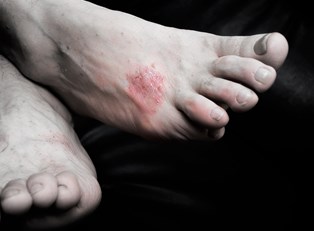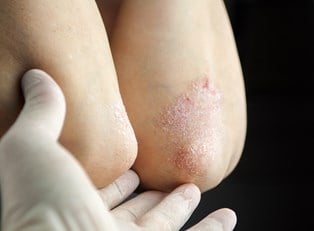Plaque psoriasis is a painful and potentially embarrassing condition in which the skin produces too many cells. This overproduction leads to patches of thick, scaly skin that flakes and is frequently itchy. It’s possible to regulate the symptoms of plaque psoriasis, but as a chronic condition, it will continue to recur even with treatment.
This overview will answer all your questions about plaque psoriasis—including what causes it, how it’s diagnosed, and how it’s treated.
Causes of Plaque Psoriasis
Researchers are still not exactly sure about the causes of plaque psoriasis, but there is a general consensus that the condition probably has something to do with problems in the immune system. The human body contains specialized cells known as “T cells” that normally move throughout the body and attack foreign entities like bacteria and viruses. However, in people with plaque psoriasis, these T cells attack healthy skin cells as well. Unfortunately, it’s still unclear as to why these T cells begin to attack healthy cells in the first place, although there is clearly a genetic component to this disease.
Triggers for Plaque Psoriasis
Even if a person has plaque psoriasis, his or her breakouts may be relatively mild. However, there are a few triggers or risk factors that can make the condition much worse. Skin injuries or infections are one of the most common triggers. Even something as seemingly insignificant as a bug bite can lead to a major outbreak for someone with plaque psoriasis.
Additionally, there are some lifestyle factors that put people at a higher risk, including smoking and obesity. Smoking diminishes the overall health of skin, while being overweight puts a person at risk of developing plaque psoriasis in skin folds or creases that are difficult to reach. Finally, cold weather is a trigger for some people with the condition, as long exposure to low temperatures can cause skin damage.
Diagnosis for Plaque Psoriasis
Plaque psoriasis is a very visible condition, and for this reason it’s often easy for doctors to make an accurate diagnosis. The most important aspect of the diagnosis process is ruling out any other similar skin conditions, such as ringworm, dermatitis, or rosea. A small skin biopsy may be necessary for this, but it is quick, painless, and can be performed in a doctor’s office.
Treatments for Plaque Psoriasis
Unfortunately, there is no definitive cure for plaque psoriasis. Instead, treatment revolves around limiting symptoms in two ways: reducing the production of skin cells by the body and removing the excess skin cells that are already present.
For mild to moderate cases of the condition, topical treatments are a popular and effective choice. Ointments containing corticosteroids help suppress the immune system and reduce the overall amount of skin cells being produced. These types of products are available by prescription only. On the other hand, salicylic acid, which is available in numerous over the counter products, helps slough off dead skin cells. Many times, patients will use a combination of these two for the most powerful results.
There is also some evidence to indicate that phototherapy, or exposure to UV rays, can help treat plaque psoriasis. Most simply, patients can experience the benefits of this by exposing themselves to sunlight. The UV rays created by the sun kill the T cells in the skin, which both reduces the number of cells being produce and helps smooth out plaque patches that are already on the skin. However, patients should exercise caution when exposing themselves to the sun by limiting the amount of time they spend in it—even mild sunburns can cause serious problems for people with this condition.



